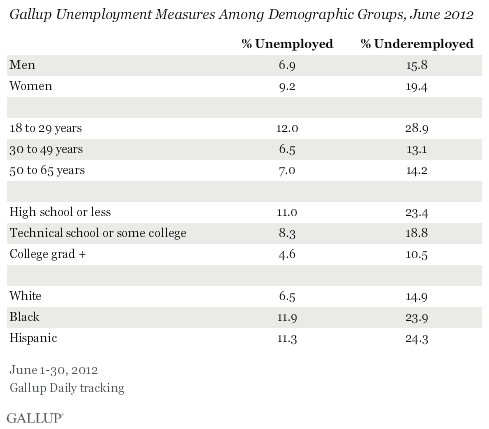WASHINGTON, D.C. -- U.S. unemployment, as measured by Gallup without seasonal adjustment, was 8.0% in June, unchanged from May, but significantly better than the 8.7% from a year ago. Gallup's seasonally adjusted number, based on applying an estimate of the government's June adjustment, is 7.8%, an improvement from 8.3% in May, and down considerably from 8.5% in June 2011. Both the unadjusted and the adjusted numbers are at least tied for the lowest Gallup has recorded since it began collecting employment data in 2010.
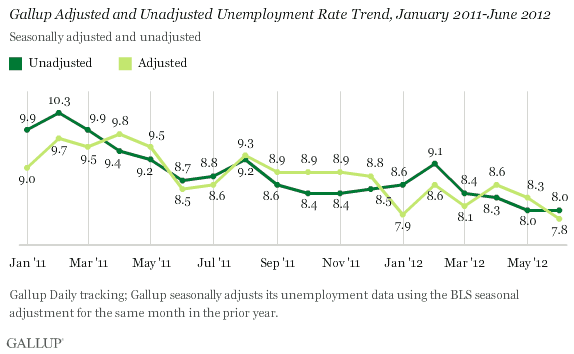
These results are based on Gallup Daily tracking interviews, conducted by landline and cell phone, with more than 30,000 Americans throughout the month. Gallup calculates a seasonally adjusted unemployment rate by applying the adjustment factor the government used for the same month in the previous year. The government adjusted its May numbers up last year, but adjusted the June numbers down, which accounts for the change in seasonally adjusted unemployment between May and June.
U.S. underemployment, as measured without seasonal adjustment, dropped to 17.5% in June, down from 18% the previous month, and the lowest since November 2010. Gallup's U.S. underemployment measure combines the unemployed with those working part time but looking for full-time work. Gallup does not apply a seasonal adjustment to underemployment.
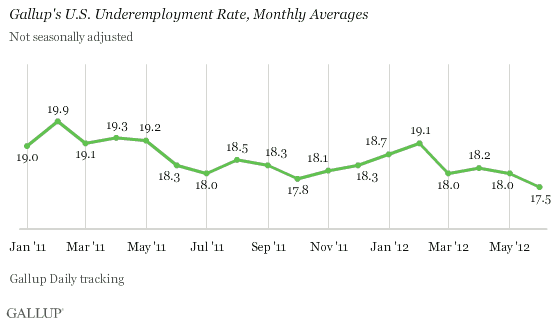
The number of part-timers wanting full-time work dropped to 9.5%, accounting for all of the improvement in underemployment. However, it is little changed from 9.6% a year ago, when a similar decline was recorded from May to June. It may be that the improvement in June was the result of summer seasonal hiring, and won't continue into the fall.
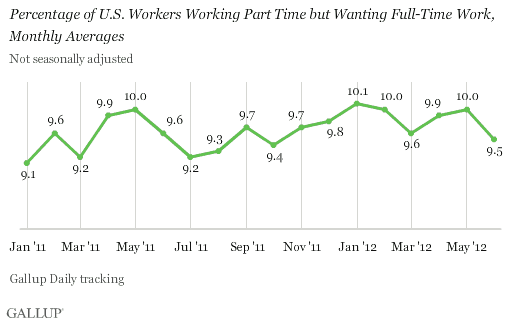
Forty-five percent of underemployed workers in the U.S. are hopeful they will find a job or full-time work in the next four weeks, a slight deterioration from 47% a month ago. Hope declined among both the unemployed and part-timers wanting full-time work. However, workers remain more hopeful about finding work than they did in January through March.
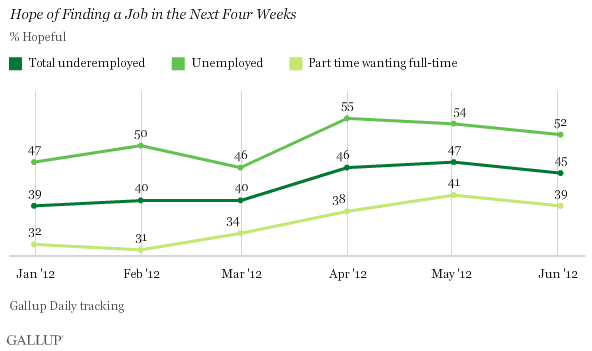
Implications
The employment situation in the U.S. remains fragile, which is reflected in the pullback in reported hope for a job. Job seekers may be reacting to less-than-optimistic discussions of the economy by the news media, as reflected in a lowered economic confidence rating in June. Just as likely, though, is that the decline is the result of real challenges Americans in the workforce faced during the job hunt in June.
Gallup's drop in seasonally adjusted unemployment suggests that the U.S. Bureau of Labor Statistics may report a decline in unemployment when the numbers are released on Friday. However, as Gallup's unadjusted data show, little has changed month over month, and just as many Americans were unemployed in June as in May.
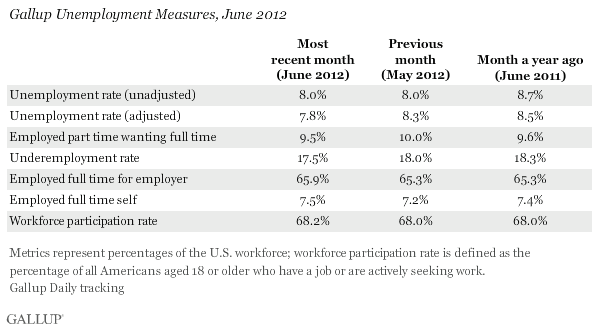
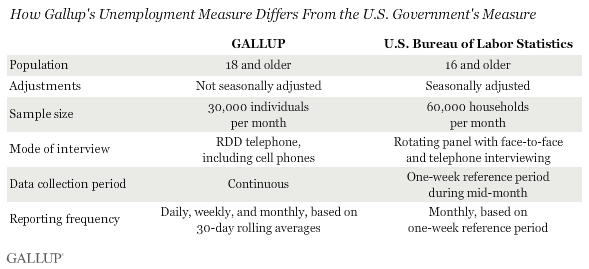
Gallup.com reports results from these indexes in daily, weekly, and monthly averages and in Gallup.com stories. Complete trend data are always available to view and export in the following charts:
Daily: Employment, Economic Confidence, Job Creation, Consumer Spending
Weekly: Employment, Economic Confidence, Job Creation, Consumer Spending
Read more about Gallup's economic measures.
View our economic release schedule.
Survey Methods
Results are based on telephone interviews conducted as part of Gallup Daily tracking from June 1-30, with a random sample of 30,294 adults, aged 18 and older, living in all 50 U.S. states and the District of Columbia, selected using random-digit-dial sampling.
For results based on the total sample of national adults, one can say with 95% confidence that the maximum margin of sampling error is ±1 percentage point.
Interviews are conducted with respondents on landline telephones and cellular phones, with interviews conducted in Spanish for respondents who are primarily Spanish-speaking. Each sample includes a minimum quota of 400 cell phone respondents and 600 landline respondents per 1,000 national adults, with additional minimum quotas among landline respondents by region. Landline telephone numbers are chosen at random among listed telephone numbers. Cell phone numbers are selected using random-digit-dial methods. Landline respondents are chosen at random within each household on the basis of which member had the most recent birthday.
Samples are weighted by gender, age, race, Hispanic ethnicity, education, region, adults in the household, and phone status (cell phone only/landline only/both, cell phone mostly, and having an unlisted landline number). Demographic weighting targets are based on the March 2011 Current Population Survey figures for the aged 18 and older non-institutionalized population living in U.S. telephone households. All reported margins of sampling error include the computed design effects for weighting and sample design.
In addition to sampling error, question wording and practical difficulties in conducting surveys can introduce error or bias into the findings of public opinion polls.
For more details on Gallup's polling methodology, visit www.gallup.com.
